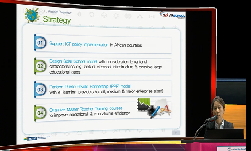본 연구의 목적은 한국과 중국 피아노학원의 현황을 조사하고, 피아노학원의 역사발전, 교육(레슨방식, 교재, 등급시험 제도, 이론 수업), 경영(수업 시간, 수업비용, 악기구매, 학부모 참여, ...
http://chineseinput.net/에서 pinyin(병음)방식으로 중국어를 변환할 수 있습니다.
변환된 중국어를 복사하여 사용하시면 됩니다.
- 中文 을 입력하시려면 zhongwen을 입력하시고 space를누르시면됩니다.
- 北京 을 입력하시려면 beijing을 입력하시고 space를 누르시면 됩니다.

중국과 한국의 피아노학원 교육 비교 연구 = Comparative Study on Piano Academy Education in China and South Korea
한글로보기https://www.riss.kr/link?id=A109603033
- 저자
- 발행기관
- 학술지명
- 권호사항
-
발행연도
2025
-
작성언어
-
- 주제어
-
KDC
600
-
등재정보
KCI등재
-
자료형태
학술저널
- 발행기관 URL
-
수록면
29-55(27쪽)
- 제공처
-
0
상세조회 -
0
다운로드
부가정보
국문 초록 (Abstract)
본 연구의 목적은 한국과 중국 피아노학원의 현황을 조사하고, 피아노학원의 역사발전, 교육(레슨방식, 교재, 등급시험 제도, 이론 수업), 경영(수업 시간, 수업비용, 악기구매, 학부모 참여, 교사의 자질) 3가지 방면으로 양국의 피아노학원 운영 특성을 비교 분석하는 것이다. 본 논문은 문헌 연구를 통해 한국과 중국의 피아노학원 교육을 비교하여, 양국의 피아노 교육의 차이점, 공통점, 장단점 등을 정리하고 발전 방향을 연구하였다. 연구결과를 살펴보면, 한국은 개인 레슨 중심으로만 운영되는 반면, 중국은 개인 레슨과 그룹 레슨을 혼용해 사용하는 것으로 조사되었다. 수업 시간의 구성은 한국의 경우 짧은 레슨시간으로 운영되지만, 중국은 45분이나 1시간의 충분한 레슨시간을 제공하는 것으로 조사되었다. 또한 한국은 등급시험 제도의 효용성을 찾기 어려운 반면, 중국에서는 등급시험에 대한 열기가 강하고 시험 준비를 중심으로 피아노 수업이 진행되었다. 중국의 등급시험은 해외의 시험제도를 모델로 두었기에, 피아노 연주 뿐만이 아닌, 테크닉, 초견, 이론 등 포괄적 음악성 발달을 기초로 하였다. 그 외에도 피아노 레슨 시, 학부모의 참여를 적극 권장하는 것도 중국 피아노 교육의 큰 차이점이다. 본 연구를 통해 양국의 피아노학원 교육과 운영을 강화하고 양국의 학원 경영자들에게 이론적 토대를 제공해 학원의 효율적인 발전에 도움이 되기를 바란다.
다국어 초록 (Multilingual Abstract)
The purpose of this study is to investigate the current status of piano schools in Korea and China, and to compare and analyze the characteristics of piano school operation in the two countries in terms of three aspects: historical development, educat...
The purpose of this study is to investigate the current status of piano schools in Korea and China, and to compare and analyze the characteristics of piano school operation in the two countries in terms of three aspects: historical development, education (lesson methods, teaching materials, grading examination system, and theory classes), and management (class hours, class fee, instrument purchase, parental participation, and teacher qualifications). This paper compares piano school education in Korea and China through literature review, organizes the differences, similarities, advantages and disadvantages of piano education in the two countries, and studies the direction of development. The research results show that Korea operates solely on private lessons, while China uses a mix of private and group lessons. While Korea’s grading system has lost its effectiveness, China’s grading system is so popular that classes are centered on preparing for the grading exam. In addition, China’s grading exam is modeled after overseas exam systems, so it is based on comprehensive musical development, including not only piano performance but also technique, sight-reading, and theory. In terms of the composition of class time, Korea provides a short time to teach all students every day, but in China, it was found that lesson time of 45 minutes or 1 hour is provided similar to private lessons. In addition, it is a big difference in Chinese piano education that parents are actively encouraged to participate in piano lessons. Through this study, it is hoped that piano education and management in academies in both countries will be strengthened and a theoretical foundation will be provided to academy managers in both countries to help academy managers develop efficiently.
동일학술지(권/호) 다른 논문
-
시각 장애인들의 대학 교육 경험에 대한 질적 사례: 피아노 전공을 대상으로
- 한국피아노교수법학회
- 김윤주 ( Kim Yunju )
- 2025
- KCI등재
-
창의적 즉흥연주의 두뇌 메커니즘: 즉흥연주에 대한 인지신경과학 연구의 검토
- 한국피아노교수법학회
- 윤수민 ( Yoon Sumin )
- 2025
- KCI등재
-
- 한국피아노교수법학회
- 전혜린 ( Jeon Hyelyn )
- 2025
- KCI등재
-
스크리아빈의 신지학적 상징주의 연구: 피아노 소나타 제 7, 9, 10번 중심으로
- 한국피아노교수법학회
- 최유리 ( Choi Yu-lee )
- 2025
- KCI등재
분석정보
연관 공개강의(KOCW)
-

Lessons from the Tsunami
Teachers TV Teachers TV -

Lessons from the Horse Whisperer
Teachers TV Teachers TV -

2014 이러닝 국제 콘퍼런스 : What is the Lessons from Education Support Project~
한국교육정보진흥협회 Boseon, Kim -

Attainment and Inclusion: Lessons Learnt
Teachers TV Teachers TV -

Boost Your Teaching: Transitions During Lessons
Teachers TV Teachers TV




 KISS
KISS

